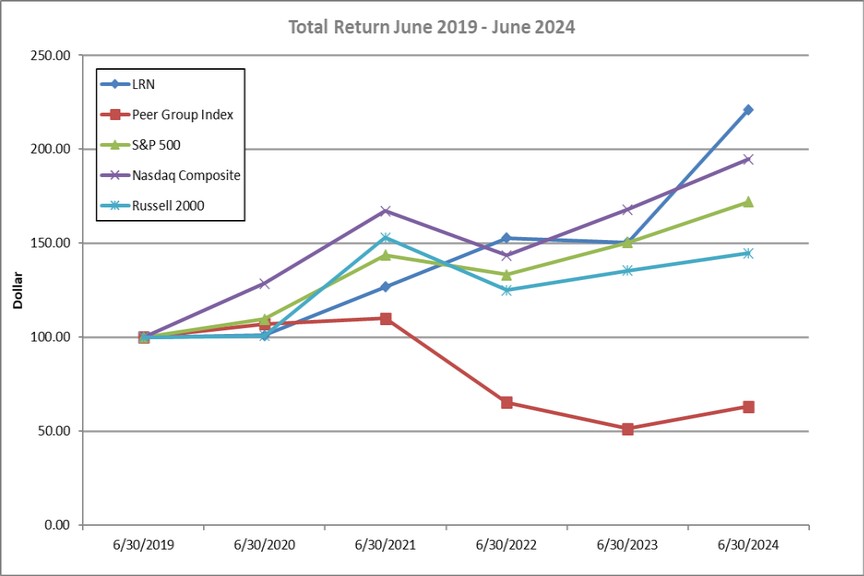Comparison of the Years Ended June 30, 2023 and 2022
Revenues. Our revenues for the year ended June 30, 2023 were $1,837.4 million, representing an increase of $150.7 million, or 8.9%, from $1,686.7 million for the year ended June 30, 2022. General Education revenues decreased $142.4 million, or 11.2%, year over year. The decrease in General Education revenues was primarily due to the 21.6% decrease in enrollments, and changes to school mix (distribution of enrollments by school). Career Learning revenues increased $293.1 million, or 71.0%, primarily due to a 57.3% increase in enrollments and school mix.
Instructional costs and services expenses. Instructional costs and services expenses for the year ended June 30, 2023 were $1,190.3 million, representing an increase of $100.1 million, or 9.2%, from $1,090.2 million for the year ended June 30, 2022. This increase in expense was due to hiring of personnel in growth states and salary increases. Instructional costs and services expenses were 64.8% of revenues during the year ended June 30, 2023, an increase from 64.6% for the year ended June 30, 2022.
Selling, general, and administrative expenses. Selling, general, and administrative expenses for the year ended June 30, 2023 were $481.6 million, representing an increase of $41.8 million, or 9.5%, from $439.8 million for the year ended June 30, 2022. The increase was primarily due to an increase of $31.3 million in personnel and related benefit costs and $17.4 million in professional services and marketing expenses, partially offset by a decrease of $6.5 million in bad debt expense and $1.5 million in net operating lease expense. Selling, general, and administrative expenses were 26.2% of revenues during the year ended June 30, 2023, an increase from 26.1% for the year ended June 30, 2022.
Interest income (expense), net. Net interest expense for the year ended June 30, 2023 was $8.4 million as compared to $8.3 million in the year ended June 30, 2022. The increase in net interest expense was primarily due to an increase in interest expense related to our finance leases.
Other income (expense), net. Other income, net for the year ended June 30, 2023 was $15.5 million as compared to other expense, net of $1.3 million in the year ended June 30, 2022. The increase in other income, net was primarily due to the increase in our investments in marketable securities and the returns on those investments year over year.
Income tax expense. Income tax expense was $45.3 million for the year ended June 30, 2023, or 26.3% of income before taxes, as compared to $40.1 million, or 27.2% of income before taxes for the year ended June 30, 2022. The decrease in the effective income tax rate for the year ended June 30, 2023, as compared to the effective tax rate for the year ended June 30, 2022, was primarily due to the decrease in the amount of non-deductible compensation, which was partially offset by the decrease in excess tax benefit of stock-based compensation.
Discussion of Seasonality of Financial Condition
Certain accounts in our balance sheet are subject to seasonal fluctuations. As our enrollments and revenues grow, we expect these seasonal trends to be amplified. The bulk of our materials are shipped to students prior to the beginning of the school year, usually in July or August. In order to prepare for the upcoming school year, we generally build up inventories during the fourth quarter of our fiscal year. Therefore, inventories tend to be at the highest levels at the end of our fiscal year. In the first quarter of our fiscal year, inventories tend to decline significantly as materials are shipped to students. In our fourth quarter, inventory purchases and the extent to which we utilize early payment discounts will impact the level of accounts payable.
Accounts receivable balances tend to be at the highest levels in the first quarter of our fiscal year as we begin billing for all enrolled students and our billing arrangements include upfront fees for many of the elements of our offering. These upfront fees result in seasonal fluctuations to our deferred revenue balances. We routinely monitor state legislative activity and regulatory proceedings that might impact the funding received by the schools we serve and to the extent possible, factor potential outcomes into our business planning decisions.
Liquidity and Capital Resources
As of June 30, 2024, we had net working capital, or current assets minus current liabilities, of $1,001.2 million. Our working capital includes cash and cash equivalents of $500.6 million and accounts receivable of $472.8 million. Our working capital provides a significant source of liquidity for our normal operating needs. Our accounts receivable balance fluctuates throughout the fiscal year based on the timing of customer billings and collections and tends to be highest in our
